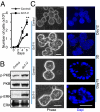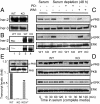Specific posttranslational modification regulates early events in mammary carcinoma formation
- PMID: 21078982
- PMCID: PMC3000280
- DOI: 10.1073/pnas.1013405107
Specific posttranslational modification regulates early events in mammary carcinoma formation
Abstract
The expression of an enzyme, GnT-V, that catalyzes a specific posttranslational modification of a family of glycoproteins, namely a branched N-glycan, is transcriptionally up-regulated during breast carcinoma oncogenesis. To determine the molecular basis of how early events in breast carcinoma formation are regulated by GnT-V, we studied both the early stages of mammary tumor formation by using 3D cell culture and a her-2 transgenic mouse mammary tumor model. Overexpression of GnT-V in MCF-10A mammary epithelial cells in 3D culture disrupted acinar morphogenesis with impaired hollow lumen formation, an early characteristic of mammary neoplastic transformation. The disrupted acinar morphogenesis of mammary tumor cells in 3D culture caused by her-2 expression was reversed in tumors that lacked GnT-V expression. Moreover, her-2-induced mammary tumor onset was significantly delayed in the GnT-V null tumors, evidence that the lack of the posttranslational modification catalyzed by GnT-V attenuated tumor formation. Inhibited activation of both PKB and ERK signaling pathways was observed in GnT-V null tumor cells. The proportion of tumor-initiating cells (TICs) in the mammary tumors from GnT-V null mice was significantly reduced compared with controls, and GnT-V null TICs displayed a reduced ability to form secondary tumors in NOD/SCID mice. These results demonstrate that GnT-V expression and its branched glycan products effectively modulate her-2-mediated signaling pathways that, in turn, regulate the relative proportion of tumor initiating cells and the latency of her-2-driven tumor onset.
Conflict of interest statement
The authors declare no conflict of interest.
Figures





Similar articles
-
Transcriptional regulation of the protocadherin β cluster during Her-2 protein-induced mammary tumorigenesis results from altered N-glycan branching.J Biol Chem. 2012 Jul 20;287(30):24941-54. doi: 10.1074/jbc.M112.369355. Epub 2012 Jun 4. J Biol Chem. 2012. PMID: 22665489 Free PMC article.
-
Deletion of mouse embryo fibroblast N-acetylglucosaminyltransferase V stimulates alpha5beta1 integrin expression mediated by the protein kinase C signaling pathway.J Biol Chem. 2005 Mar 4;280(9):8332-42. doi: 10.1074/jbc.M413532200. Epub 2004 Dec 22. J Biol Chem. 2005. PMID: 15615721
-
Post-translational glycoprotein modifications regulate colon cancer stem cells and colon adenoma progression in Apc(min/+) mice through altered Wnt receptor signaling.J Biol Chem. 2014 Nov 7;289(45):31534-49. doi: 10.1074/jbc.M114.602680. Epub 2014 Oct 1. J Biol Chem. 2014. PMID: 25274627 Free PMC article.
-
Implication of N-acetylglucosaminyltransferases III and V in cancer: gene regulation and signaling mechanism.Biochim Biophys Acta. 1999 Oct 8;1455(2-3):287-300. doi: 10.1016/s0925-4439(99)00066-6. Biochim Biophys Acta. 1999. PMID: 10571019 Review.
-
Physiological roles of N-acetylglucosaminyltransferase V(GnT-V) in mice.BMB Rep. 2012 Oct;45(10):554-9. doi: 10.5483/bmbrep.2012.45.10.190. BMB Rep. 2012. PMID: 23101508 Review.
Cited by
-
Glycosylation and liver cancer.Adv Cancer Res. 2015;126:257-79. doi: 10.1016/bs.acr.2014.11.005. Epub 2015 Feb 7. Adv Cancer Res. 2015. PMID: 25727150 Free PMC article. Review.
-
The bisecting GlcNAc in cell growth control and tumor progression.Glycoconj J. 2012 Dec;29(8-9):609-18. doi: 10.1007/s10719-012-9373-6. Epub 2012 Apr 4. Glycoconj J. 2012. PMID: 22476631 Free PMC article. Review.
-
N-glycosylation by N-acetylglucosaminyltransferase V enhances the interaction of CD147/basigin with integrin β1 and promotes HCC metastasis.J Pathol. 2018 May;245(1):41-52. doi: 10.1002/path.5054. Epub 2018 Mar 30. J Pathol. 2018. PMID: 29431199 Free PMC article.
-
Effects of N361 Glycosylation on Epidermal Growth Factor Receptor Biological Function.bioRxiv [Preprint]. 2024 Jul 16:2024.07.12.603279. doi: 10.1101/2024.07.12.603279. bioRxiv. 2024. PMID: 39071333 Free PMC article. Preprint.
-
Glycosyltransferase Gene Expression Profiles Classify Cancer Types and Propose Prognostic Subtypes.Sci Rep. 2016 May 20;6:26451. doi: 10.1038/srep26451. Sci Rep. 2016. PMID: 27198045 Free PMC article.
References
-
- Ménard S, et al. HER2 overexpression in various tumor types, focussing on its relationship to the development of invasive breast cancer. Ann Oncol. 2001;12(Suppl 1):S15–S19. - PubMed
-
- Sorkin A, Goh LK. Endocytosis and intracellular trafficking of ErbBs. Exp Cell Res. 2009;315:683–696. - PubMed
-
- Holbro T, Civenni G, Hynes NE. The ErbB receptors and their role in cancer progression. Exp Cell Res. 2003;284:99–110. - PubMed
Publication types
MeSH terms
Substances
Grants and funding
LinkOut - more resources
Full Text Sources
Molecular Biology Databases
Research Materials
Miscellaneous

